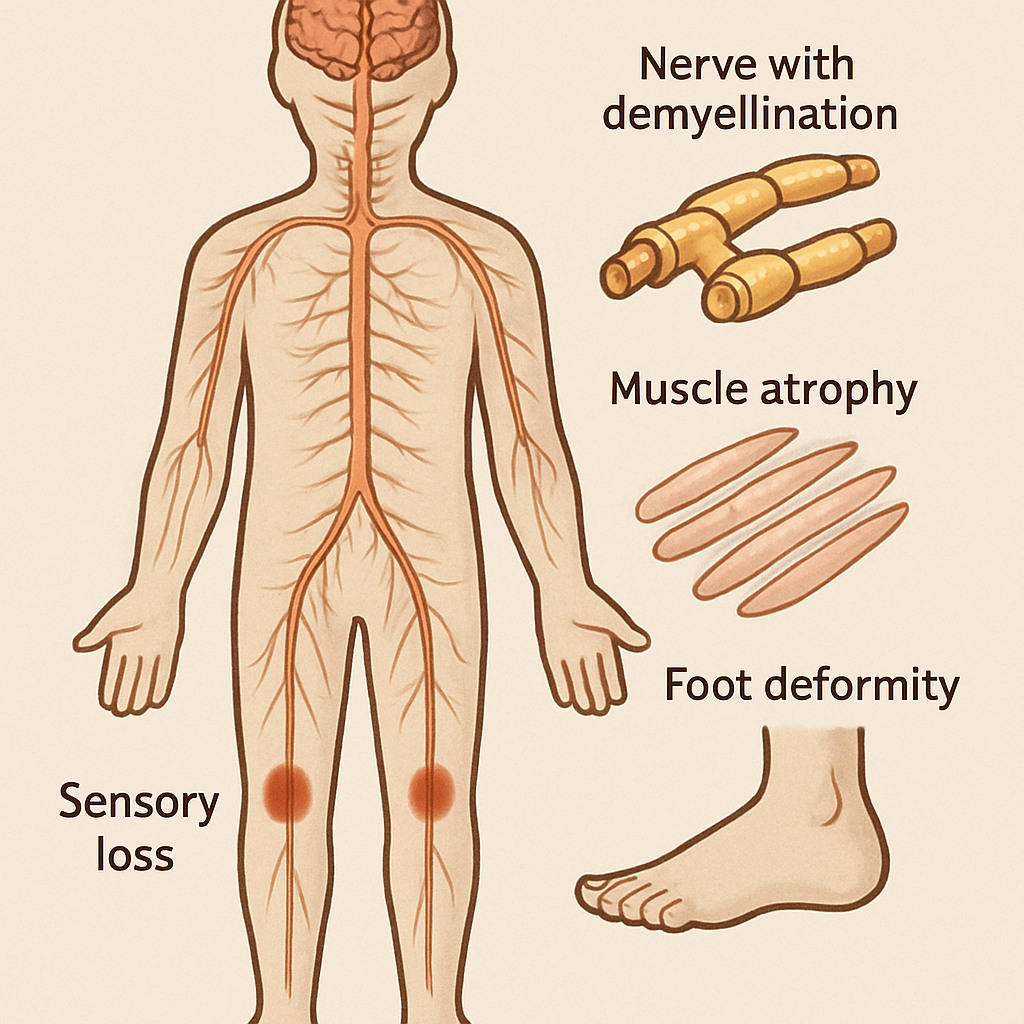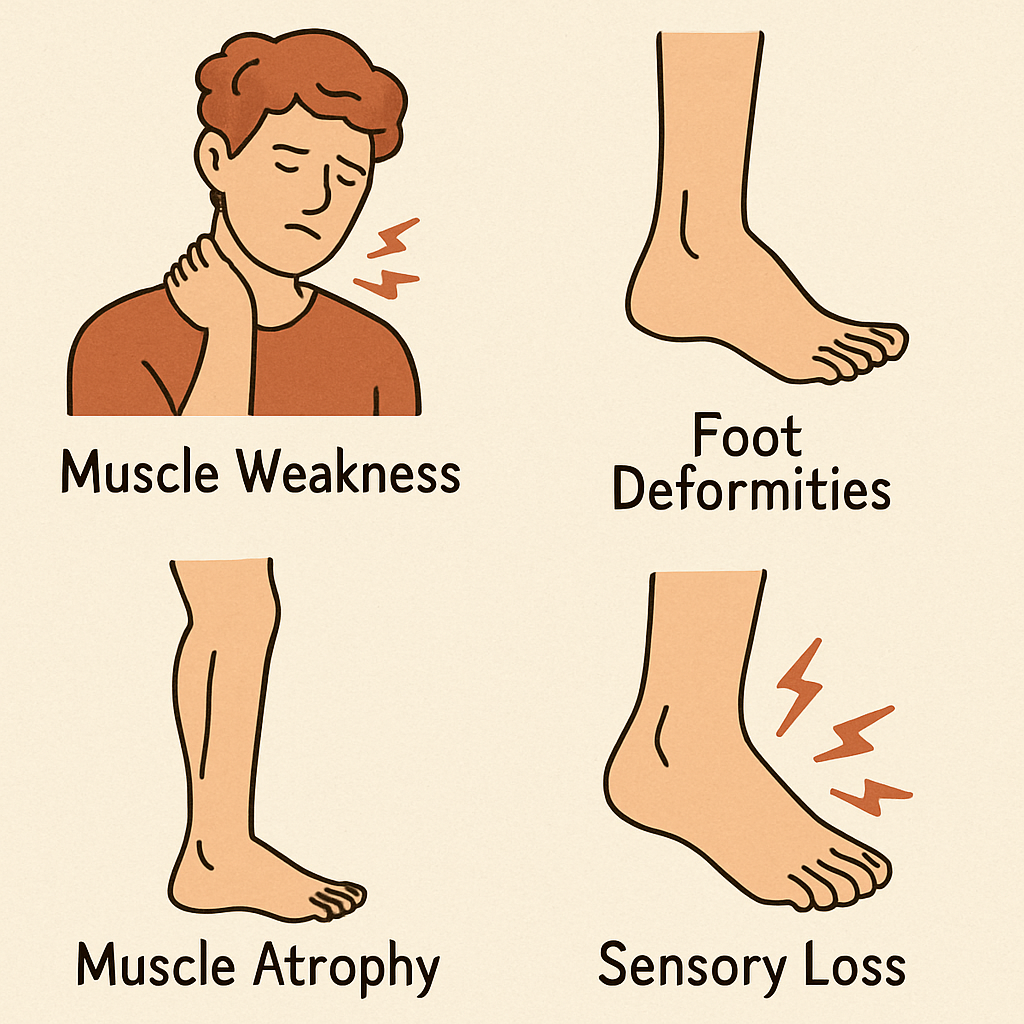
What is HMSN Disease?
HMSN is a hereditary condition, meaning it is passed down through families. It is characterised by a gradual loss of muscle tissue and touch sensation across various parts of the body. The disease gets its name from three doctors who first identified it: Jean-Martin Charcot, Pierre Marie, and Howard Henry Tooth.
Types of HMSN
There are several types of HMSN, each with its specific genetic cause and symptoms. The most common types include:
- CMT1: This type involves abnormalities in the myelin sheath, which is the protective covering of the nerve fibres. It usually begins in childhood or early adulthood.
- CMT2: This type affects the axon, or the part of the nerve cell that sends signals to other cells. It tends to have a later onset than CMT1.
- CMT3: Also known as Dejerine-Sottas disease, this is a rare and severe form of CMT that begins in infancy.
Symptoms of HMSN

- Muscle Weakness: This often begins in the lower legs and feet but can also affect the hands and arms. The weakness may lead to difficulty in walking, balance issues, and a higher risk of falling.
- Foot Deformities: High arches, hammertoes, and flat feet are common in individuals with HMSN due to muscle imbalances.
- Loss of Sensation: Many people experience numbness or a reduced ability to feel temperature changes or pain, particularly in the feet and hands.
- Pain: Some individuals may experience pain due to muscle cramps or nerve damage.
- Difficulty with Fine Motor Skills: Tasks such as buttoning a shirt or writing can become challenging.
Diagnosing HMSN
Diagnosis typically involves a combination of medical history, physical examinations, and specific tests.
Tests Used
- Nerve Conduction Studies: These tests measure the speed and strength of signals travelling through your nerves.
- Electromyography (EMG): This test records the electrical activity in your muscles to identify abnormalities.
- Genetic Testing: Identifying mutations in specific genes can confirm the diagnosis of HMSN.
Treatment Options
Currently, there is no cure for HMSN, but there are ways to manage the symptoms and improve quality of life.
Physical Therapy
Physical therapy is a cornerstone of HMSN treatment. It helps maintain muscle strength, flexibility, and balance. A tailored exercise program can also prevent muscle contractures and joint deformities.
Occupational Therapy
Occupational therapy focuses on improving daily living skills and may involve learning new techniques or using assistive devices to manage tasks effectively.
Orthopedic Devices
Braces, splints, or orthopaedic footwear can provide support, improve mobility, and prevent injury. Neuropathy footwear is specially designed to alleviate pressure points and provide stability.
Pain Management
Pain, if present, can be managed through medications, physical therapy, or alternative treatments like acupuncture.
Surgery
In some cases, surgery may be necessary to correct severe foot deformities or to stabilise joints.
The Role of Footwear in Managing HMSN
Proper footwear plays a vital role in managing HMSN. As the disease often affects the feet, choosing the right shoes can alleviate symptoms and prevent further complications. Here's why neuropathy footwear is important:
- Support and Stability: Shoes designed for neuropathy provide extra support and help stabilise the foot, reducing the risk of falls.
- Pressure Relief: Neuropathy shoes often have cushioning to relieve pressure points, which is crucial for individuals with reduced sensation.
- Custom Fit: Many neuropathy shoes can be custom-fitted to accommodate foot deformities like high arches or hammertoes.
- Breathability and Comfort: The materials used in these shoes are often breathable and soft, preventing irritation and discomfort.
Living with HMSN
Living with HMSN requires ongoing management and adjustments to daily life. Here are some tips for coping with the disease:
- Stay Active: Regular exercise helps maintain muscle strength and flexibility.
- Monitor Your Feet: Regularly check your feet for sores or injuries, especially if you have reduced sensation.
- Seek Support: Joining support groups or connecting with others who have HMSN can provide valuable emotional support and practical advice.
- Educate Yourself: Understanding your condition and treatment options empowers you to make informed decisions about your health.
Conclusion
Hereditary Motor Sensory Neuropathy is a complex disease, but with proper management and care, individuals can lead fulfilling lives. Understanding the symptoms and treatment options, along with the importance of appropriate footwear, can make a significant difference in managing the condition. If you suspect you have symptoms of HMSN, consult with a healthcare professional for a comprehensive evaluation and personalized treatment plan.








